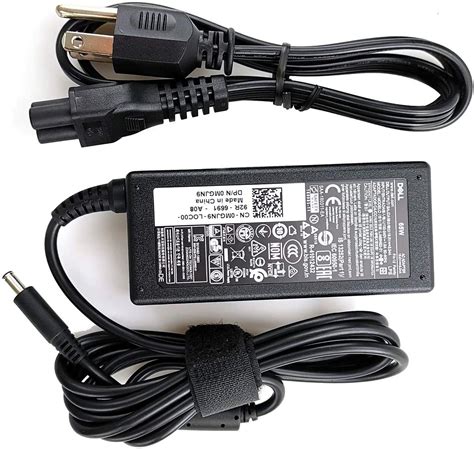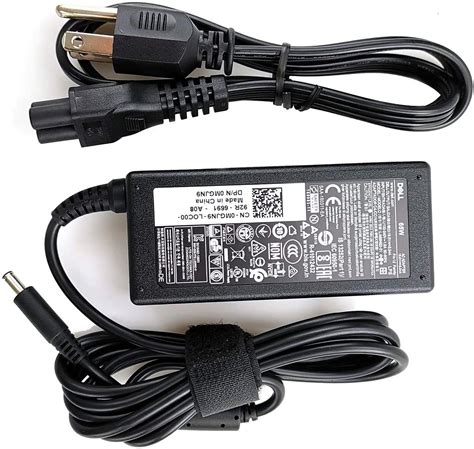How to Spot a Fake Dell Laptop Charger: A Comprehensive Guide
1. How Can I Tell If My Dell Laptop Charger Is Fake?
Identifying a genuine Dell laptop charger from a counterfeit one is crucial for ensuring your device’s safety and performance. Counterfeit chargers often pose serious risks, including:
- Overheating and fire hazards: Fake chargers may use substandard components that can overheat and cause fires.
- Damage to your laptop: Poorly designed chargers can damage your laptop’s battery and motherboard, leading to costly repairs or even device failure.
- Shortened battery life: Counterfeit chargers may not deliver the correct voltage and current, leading to faster battery degradation.
To help you differentiate between a real and a fake Dell charger, we have compiled a list of key indicators to look for:
Visual Inspection:
- Packaging: Genuine Dell chargers come in high-quality packaging with the Dell logo and model number clearly printed. Pay attention to the color, font, and overall design of the packaging. Counterfeit chargers often have poor packaging with blurry or misaligned printing.
- Cable: Genuine Dell cables are usually thicker and more durable than fake ones. Examine the cable for any loose connections, frayed wires, or uneven thickness.
- Connector: The charger connector should fit snugly into your laptop’s power port. Counterfeit connectors may be loose or misaligned.
Physical Attributes:
- Weight and feel: Genuine Dell chargers are usually heavier and feel more solid in your hand. Fake chargers may feel flimsy and lightweight.
- Build quality: Examine the plastic housing of the charger for any signs of poor molding or rough edges. Genuine chargers have smooth, well-constructed casings.
- Branding and logos: The Dell logo and model number should be clearly printed on the charger. Ensure that the logo is sharp, well-defined, and correctly aligned.
Functionality:
- LED indicator: Genuine Dell chargers have a LED indicator that lights up when the charger is plugged in and connected to power. Check if the LED light is functioning properly and emits a steady light.
- Voltage and amperage: The charger’s output voltage and amperage should match the specifications listed in your laptop’s user manual or on the Dell website. Use a multimeter to measure the output voltage and amperage, and compare it to the specifications.
Additional Tips:
- Buy from reputable sellers: Purchase your charger from authorized Dell retailers or trusted online stores like Amazon, Best Buy, or Newegg.
- Check the warranty: Genuine Dell chargers come with a warranty. If the seller is not providing a warranty, it could be a red flag.
By following these guidelines, you can increase your chances of spotting a fake Dell laptop charger and protecting your device from potential damage.

2. What Are the Risks of Using a Fake Dell Laptop Charger?
Using a counterfeit Dell laptop charger can pose significant risks to your device and personal safety. These risks can be categorized into three main areas:
2.1. Damage to Your Laptop:
Fake chargers often fail to meet the electrical specifications required by your Dell laptop. This can result in several problems, including:
- Overheating and Battery Failure: Fake chargers might deliver incorrect voltage or amperage, causing the battery to overheat. This can lead to reduced battery lifespan, battery swelling, or even explosions.
- Motherboard Damage: The improper voltage and amperage can also damage your laptop’s motherboard. This can result in costly repairs or even the complete failure of your laptop.
- Power Surge Damage: Fake chargers may lack proper surge protection, making your laptop vulnerable to power surges that can damage the motherboard or other components.
2.2. Fire Hazards:
Counterfeit chargers often use cheap and substandard components, which can overheat and pose a serious fire risk. The faulty wiring, insulation, or circuit boards in fake chargers can lead to overheating and potential fires, especially when left unattended.
2.3. Security Risks:
Fake chargers may also contain malware or vulnerabilities that can compromise your device’s security. Some counterfeit chargers might be equipped with malicious software that can steal your personal information or access your sensitive data.
It’s important to remember that the risks associated with using a fake Dell laptop charger outweigh any potential cost savings. Always prioritize safety and invest in a genuine charger to protect your laptop and your data.
3. Where Can I Buy a Genuine Dell Laptop Charger?
To ensure you are getting a genuine Dell laptop charger, it’s crucial to purchase from reputable sources. Here are some recommended places to buy:
3.1. Dell Website:
The official Dell website is the most reliable place to buy a genuine Dell laptop charger. You can find all the compatible chargers for your specific laptop model.
3.2. Authorized Dell Retailers:
Major electronics retailers like Best Buy, Amazon, and Newegg often have authorized Dell retail stores or online sections. These retailers sell genuine Dell products with warranties and guarantees.
3.3. Dell Support Centers:
Dell Support Centers can provide genuine Dell chargers directly. They can also diagnose your laptop and recommend the appropriate charger based on your specific needs.
Avoid buying chargers from:
- Unverified online sellers or auction sites: Be cautious of sellers who lack a good reputation or offer prices significantly lower than the market value.
- Street vendors: Avoid purchasing chargers from street vendors, as they may be counterfeit.
- Unlicensed electronics stores: Stick to authorized Dell retailers and reputable electronics stores that have a history of selling genuine products.
By following these recommendations, you can ensure that you are buying a genuine Dell charger that will meet your laptop’s power needs safely and reliably.
4. How Do I Know If My Dell Laptop Charger Is Genuine?
Several telltale signs can help you identify a genuine Dell laptop charger:
- Packaging: Genuine Dell chargers come in distinctive packaging with the Dell logo, model number, and other important information printed clearly. The packaging is usually made of high-quality materials and feels robust.
- Charger Body: The charger’s body should be made of high-quality materials with a smooth finish and no visible defects. The Dell logo should be clearly printed on the charger body, and the model number should be easily identifiable.
- Connector: The connector should fit snugly into the laptop’s power port and should have a solid, robust construction. The connector should be free of any signs of damage or wear and tear.
- Cable: The cable should be thick, durable, and well-insulated. It should have a smooth, even texture with no visible signs of fraying or damage. The connector at the end of the cable should be securely connected to the cable and should fit snugly into the charger.
- LED Indicator: Genuine Dell chargers typically have an LED indicator that lights up when the charger is plugged in and connected to power. The LED should be a consistent color and brightness, and it should not flicker or dim.
- Weight and Feel: Genuine Dell chargers feel heavier and more robust than counterfeit ones. The charger should feel solid in your hand, not flimsy or lightweight.
- Warranty: Genuine Dell chargers usually come with a one-year warranty. Check for the warranty information on the packaging or on the Dell website.
If you notice any of the following signs, it could be a fake charger:
- Poor packaging quality: Blurry or misaligned printing, flimsy materials, or missing information.
- Charger body defects: Rough edges, uneven finish, faded logo, or a flimsy feel.
- Loose connector: The connector doesn’t fit snugly into the laptop’s power port or appears to be loose or wobbly.
- Damaged cable: Frayed wires, uneven thickness, or a loose connector at the end of the cable.
- Flickering or dim LED indicator: The LED light doesn’t illuminate consistently or flickers or dims intermittently.
- Lightweight and flimsy feel: The charger feels lightweight and cheap.
- Missing warranty information: The packaging or seller doesn’t provide any warranty details.
Be cautious when purchasing a Dell laptop charger and take the time to examine it thoroughly before using it. A little diligence can go a long way in protecting your laptop and ensuring its long-term performance.
5. Can I Use a Third-Party Dell Laptop Charger?
While using a third-party Dell laptop charger might seem like a cost-effective option, it’s crucial to understand the risks involved. Here’s what you need to know:
5.1. Compatibility:
Not all third-party chargers are compatible with Dell laptops. The charger’s output voltage and amperage must match the specifications of your Dell laptop. Using an incompatible charger can damage your laptop’s battery or other components.
5.2. Safety Standards:
Third-party chargers may not meet the same safety standards as genuine Dell chargers. They might lack proper insulation, fire protection, or surge protection, leading to overheating, fire hazards, or damage to your laptop.
5.3. Warranty:
Third-party chargers may not come with a warranty. If something goes wrong with the charger, you might be left with a damaged laptop and no recourse for repairs or replacement.
Tips for Using Third-Party Chargers:
- Research thoroughly: Read reviews and research the manufacturer before buying a third-party charger.
- Check compatibility: Ensure that the charger’s output voltage and amperage match your laptop’s specifications.
- Look for safety certifications: Opt for chargers with safety certifications like UL or ETL.
- Purchase from reputable sellers: Buy from trusted online retailers or local electronics stores that have a good track record of selling quality products.
It’s generally recommended to use genuine Dell chargers for optimal compatibility, safety, and warranty protection. However, if you decide to use a third-party charger, exercise caution, conduct thorough research, and prioritize safety.
6. How Can I Identify a Genuine Dell Laptop Charger from a Fake One?
There are several key differences between a genuine Dell laptop charger and a fake one. Here are some telltale signs to look for:
6.1. Visual Inspection:
Packaging:
- Genuine: High-quality packaging with clear, sharp printing of the Dell logo, model number, and other information. The packaging is typically made of sturdy cardboard or plastic.
- Fake: Low-quality packaging with blurry or misaligned printing, flimsy materials, or missing information.
Charger Body:
- Genuine: Made of high-quality materials, with a smooth finish and no visible defects. The Dell logo and model number are clearly printed on the charger body.
- Fake: Made of cheap, flimsy materials with rough edges, an uneven finish, or a faded logo. The printing may be blurry, misaligned, or incomplete.
Connector:
- Genuine: Fits snugly into the laptop’s power port and has a solid, robust construction. The connector is free of any signs of damage or wear and tear.
- Fake: Loose or wobbly, doesn’t fit snugly, or shows signs of damage or wear and tear. The connector may be made of cheap materials or have a flimsy construction.
Cable:
- Genuine: Thick, durable, and well-insulated with a smooth, even texture. The connector at the end of the cable is securely connected and fits snugly into the charger.
- Fake: Frayed wires, uneven thickness, or a loose connector at the end of the cable. The cable may be made of cheap materials or have a flimsy construction.
6.2. Functionality:
LED Indicator:
- Genuine: Has a consistent color and brightness and doesn’t flicker or dim.
- Fake: Flickers, dims, or emits an inconsistent light.
Weight and Feel:
- Genuine: Feels heavier and more robust than counterfeit ones.
- Fake: Feels lightweight and cheap, lacking the solid feel of a genuine charger.
By carefully examining the visual and functional aspects of the charger, you can increase your chances of identifying a genuine Dell laptop charger from a fake one. It’s always best to err on the side of caution and choose a charger from a reputable source to ensure your laptop’s safety and performance.
7. What Should I Do If I’ve Already Bought a Fake Dell Laptop Charger?
If you suspect you may have already purchased a fake Dell laptop charger, it’s essential to take immediate action to protect your laptop. Here’s what you should do:
7.1. Stop Using the Charger:
The first step is to immediately stop using the counterfeit charger. Continued use can damage your laptop, overheat, and pose a fire risk.
7.2. Check for Damage:
Carefully examine your laptop for any signs of damage. Look for overheating, battery swelling, or other issues that might indicate the fake charger has caused harm.
7.3. Contact the Seller:
If you purchased the charger from an online retailer, contact the seller to report the counterfeit item. Inform them of your suspicions and ask for a refund or replacement with a genuine charger.
7.4. Seek Professional Assistance:
If your laptop shows signs of damage, contact Dell Support or a qualified electronics repair center to diagnose and repair any issues. They can help determine if the fake charger has caused any permanent damage and guide you on the appropriate repair options.
It’s crucial to act quickly and take necessary steps to mitigate the risks of using a fake Dell laptop charger. By taking these steps, you can protect your laptop from further damage and ensure its safety and longevity.
8. How Do I Know Which Dell Laptop Charger Is Right for My Laptop?
Choosing the correct Dell laptop charger is crucial for ensuring your laptop’s proper operation and safety. It’s essential to match the charger’s output voltage and amperage with your laptop’s specifications. Here’s a step-by-step guide:
8.1. Find Your Laptop Model:
Identify your Dell laptop model by checking the bottom or back of your device. The model number is typically printed on a sticker.
8.2. Check Dell’s Website:
Visit Dell’s website and search for your laptop model. Navigate to the “Support” or “Accessories” section and look for compatible chargers. Dell provides detailed specifications for each charger, including output voltage and amperage.
8.3. Verify Charger Specifications:
Ensure that the output voltage and amperage of the charger match your laptop’s requirements. These specifications are usually listed on the charger itself, the packaging, or on the Dell website.
8.4. Purchase from a Reputable Source:
Once you have identified the correct Dell charger, purchase it from a trusted retailer like Dell’s website, authorized Dell retailers, or reputable online marketplaces like Amazon or Best Buy.
By following these steps, you can ensure that you choose the right Dell laptop charger for your device. Always prioritize safety and compatibility when selecting a charger to maintain your laptop’s optimal performance and longevity.
9. Can I Use a Dell Laptop Charger for Another Device?
Using a Dell laptop charger for another device, such as a smartphone or tablet, is generally not recommended. Here’s why:
9.1. Compatibility Issues:
Dell laptop chargers are designed to provide specific voltage and amperage output for Dell laptops. Other devices may require different power specifications. Using an incompatible charger can damage your device’s battery or other components.
9.2. Safety Concerns:
Dell laptop chargers may not meet the safety standards required for other devices. They might lack surge protection or other features essential for other electronic devices.
9.3. Warranty Void:
Using a Dell laptop charger for another device may void the warranty of that device.
Recommendation:
It’s always best to use the charger specifically designed for your device. Using a Dell laptop charger for other devices can lead to incompatibility, safety issues, and warranty void.
10. How Often Should I Replace My Dell Laptop Charger?
There’s no set timeframe for replacing a Dell laptop charger. The lifespan of a charger depends on factors like usage frequency, storage conditions, and the quality of the charger. However, here are some indicators that suggest it might be time to replace your charger:
10.1. Physical Damage:
Examine your charger for any signs of physical damage like frayed wires, cracked casing, or a loose connector. These signs indicate that the charger might be malfunctioning and pose a safety risk.
10.2. Charger Overheating:
If your charger gets excessively hot during use, it’s a warning sign. Overheating can indicate internal damage or faulty components, and it’s best to replace the charger to avoid potential hazards.
10.3. Inconsistent Charging:
If your laptop starts experiencing slow or inconsistent charging, it could be a sign of a failing charger. The charger might not be providing the necessary voltage or amperage, leading to charging problems.
10.4. Charging Problems:
If your laptop suddenly stops charging or experiences intermittent charging issues, it’s a good idea to replace the charger. The charger might be malfunctioning and unable to provide consistent power.
It’s always best to err on the side of caution and replace your Dell laptop charger when you notice any of these signs. A new charger can ensure your laptop’s safe and efficient charging and prevent potential damage to your device.

Summary
| Question | Answer |
|---|---|
| How Can I Tell If My Dell Laptop Charger Is Fake? | Look for poor packaging, flimsy materials, blurry printing, and mismatched logos. Check for loose connectors, frayed wires, and a lightweight feel. |
| What Are the Risks of Using a Fake Dell Laptop Charger? | Overheating, battery failure, motherboard damage, fire hazards, and security risks. |
| Where Can I Buy a Genuine Dell Laptop Charger? | Purchase from Dell’s website, authorized Dell retailers, or Dell Support Centers. Avoid street vendors, unlicensed stores, and unverified online sellers. |
| How Do I Know If My Dell Laptop Charger Is Genuine? | Check for high-quality packaging, a sturdy charger body, a snug connector, a thick and durable cable, a consistent LED indicator, and a warranty. |
| Can I Use a Third-Party Dell Laptop Charger? | It’s not recommended due to compatibility issues, safety concerns, and warranty void. |
| How Do I Identify a Genuine Dell Laptop Charger from a Fake One? | Look for visual differences in packaging, charger body, connector, and cable, as well as functional differences in the LED indicator, weight, and feel. |
| What Should I Do If I’ve Already Bought a Fake Dell Laptop Charger? | Stop using the charger immediately, check your laptop for damage, contact the seller, and seek professional assistance. |
| How Do I Know Which Dell Laptop Charger Is Right for My Laptop? | Identify your laptop model, check Dell’s website for compatible chargers, verify the output voltage and amperage, and purchase from a reputable source. |
| Can I Use a Dell Laptop Charger for Another Device? | It’s not recommended due to compatibility issues, safety concerns, and warranty void. |
| How Often Should I Replace My Dell Laptop Charger? | Replace it when you notice physical damage, overheating, inconsistent charging, or charging problems. |
Frequently Asked Questions
What if my laptop is not charging at all?
If my laptop is not charging at all, what could be the problem?
There could be several reasons why your laptop is not charging. The problem might be with the charger itself, the power outlet, the laptop’s charging port, or the battery.
Start by checking if the charger is plugged in and working properly. Try a different power outlet to see if it’s a power issue. Also, inspect the laptop’s charging port for any signs of damage or debris. If all else fails, the battery might need to be replaced.
Can I charge my laptop with a different charger?
Is it safe to use a different charger for my Dell laptop?
It’s generally not recommended to use a different charger for your Dell laptop unless it’s a genuine Dell charger specifically designed for your laptop model and meets the correct voltage and amperage specifications. Using an incompatible charger can damage your battery or other components and even pose a fire risk.
What should I do if my charger is getting too hot?
My Dell laptop charger is getting extremely hot. Is this normal?
No, a charger getting excessively hot is not normal and should be a cause for concern. It could indicate internal damage or faulty components. It’s best to stop using the charger and replace it to prevent potential hazards.
Can I use my Dell laptop charger to charge other devices like my phone?
Is it safe to use my Dell laptop charger to charge my smartphone?
It’s not recommended to use your Dell laptop charger to charge other devices. Your laptop charger is designed for specific voltage and amperage output for Dell laptops, and other devices may require different power specifications.
How long should it take to charge my laptop?
How long does it normally take to fully charge a Dell laptop?
The charging time for a Dell laptop varies depending on the battery capacity and the charger’s power output. Typically, it can take anywhere from 1 to 3 hours to fully charge a Dell laptop. You can find the estimated charging time in your laptop’s user manual or on the Dell website.
What should I do if my Dell laptop battery is not holding a charge?
My Dell laptop battery doesn’t hold a charge. What can I do?
There are a few things you can try if your Dell laptop battery is not holding a charge. Start by ensuring you are using a genuine Dell charger and that the charger and power outlet are working properly. Try calibrating the battery by fully charging it and then completely draining it. If the problem persists, it’s likely the battery has reached its end of life and needs to be replaced.
How do I know if my Dell laptop charger is compatible with my laptop?
How can I tell if a charger is compatible with my Dell laptop?
The best way to ensure compatibility is to check the output voltage and amperage of the charger and compare them to your laptop’s specifications. You can find this information on the charger itself, the packaging, or on Dell’s website.



